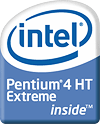Intel Pentium 4 Extreme Edition
The Intel Pentium 4 Extreme Edition (also known as Pentium 4 EE ) is a microprocessor of the seventh x86 generation that is based on the Intel Pentium 4 and adds some functions to it. In terms of market orientation, the Pentium 4 Extreme Edition can be classified as similar to AMD's Athlon 64 FX .
technology
Like the Pentium 4, the CPU is also based on the NetBurst architecture and has only been expanded to include a few functions. Because of these functions, the Pentium 4 Extreme Edition requires special chipsets that were originally intended for the Intel Xeon processors .
Models
Gallatin
The first 3.2 GHz version was a version of the Intel Xeon MP processor based on the Gallatin core that was adapted for desktop operation . It was announced on the Intel Developer Forum in September 2003 about a week before the AMD Athlon 64 was launched . Although Intel asserted that the Extreme Edition was aimed at performance-hungry gamers, most observers saw it as an attempt to dampen the thunderbolt around the AMD Athlon 64 a little. If this was actually the case, then this tactic was a failure, as the new chip was not only beaten by the Athlon 64 and Athlon 64 FX in many benchmarks, but was also barely able to outperform the 3.2 GHz Pentium 4. In terms of performance, it behaved roughly like a conventional Pentium 4 with a 3.4 GHz clock rate, which was largely due to the additional latency due to the third cache level. Some games, especially those with the Quake III or Unreal engine, as well as applications for multimedia encoding, however, benefited more than average from the additional cache.
In contrast to the Xeon MP, the front side bus of the Pentium 4 EE has been increased from 133 to 200 MHz (quad-pumped, FSB800). The level 3 cache is 2 MiB for both, but the multiprocessor capabilities were waived. Later, Intel also offered this CPU with 3.4 GHz and for the Socket 775 . An even faster version with 3.46 GHz and a front side bus with 266 MHz (quad-pumped, FSB 1066) for the Socket 775 was also offered.
Prescott 2M
With the appearance of the Pentium 4 CPUs with Prescott 2M core, this core was also used for the Pentium 4 Extreme Edition. A model with 3.73 GHz and a front side bus with 266 MHz (quad-pumped, FSB 1066) for the Socket 775 was used.
future
With the changeover to model numbers and the introduction of new dual-core CPUs ( Pentium D ), the Pentium 4 Extreme Edition was replaced by its successor, the Pentium Extreme Edition . So there will no longer be any new CPUs with the name “Pentium 4 Extreme Edition”.
Model data
Gallatin
- L1 cache: 8 KiB (data) plus 12,000 µOps (instructions)
- L2 cache: 512 KiB with processor clock
- L3 cache: 2,048 KiB with processor clock
- MMX , SSE , SSE2 , Hyper-Threading
- Socket 478 and LGA775 , AGTL + with 200 and 266 MHz front side bus ( quad-pumped : FSB 800 and 1066)
- Operating voltage ( VCore ):
- Power dissipation ( TDP ):
- Release DATE: February 2, 2004
- Manufacturing technology: 130 nm
- Transistors: 178 million
- Clock rates: 3.20-3.46 GHz
- 200 MHz FSB: 3.20 GHz (Socket 478), 3.40 GHz (Socket 478 + LGA775)
- 266 MHz FSB: 3.46 GHz (LGA775)
Prescott 2M
- L1 cache: 16 KiB (data) plus 16,000 µOps (instructions)
- L2 cache: 2,048 KiB with processor clock
- MMX , SSE , SSE2 , SSE3 , EM64T , XD-Bit , Hyper-Threading
- LGA775 , AGTL + with 266 MHz Front Side Bus (quadpumped: FSB 1066)
- Operating voltage ( VCore ):
- Power dissipation ( TDP ):
- Release DATE: February 2005
- Manufacturing technology: 90 nm
- Transistors: 169 million
- Clock rate: 3.73 GHz

